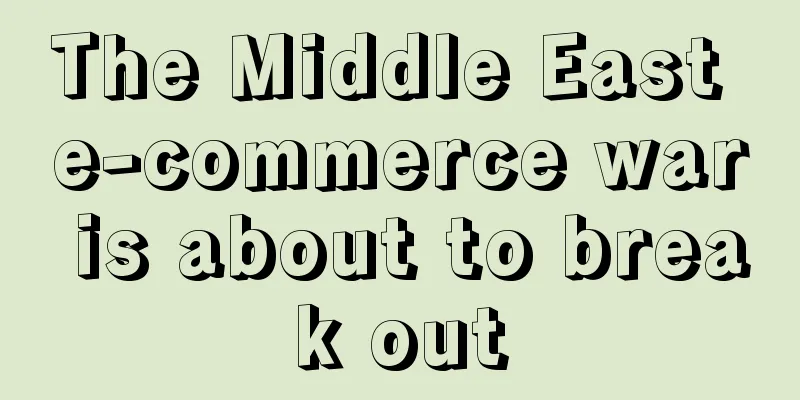The Middle East e-commerce war is about to break out

"I like this skirt very much. Its flared sleeves and waistline design are very beautiful." On the social media platform, Middle Eastern internet celebrity Jaber, wearing a light-colored headscarf, is showing her fans a dark green skirt embroidered with golden vines that she bought online specifically for Ramadan. Jaber also showed off several other brightly colored dresses in the video that she would wear during Ramadan, with rhinestones, chains and other decorations on the clothes becoming the highlight of the display. Jaber's video, which was tagged with the topic "Ramadan", has been viewed nearly 100,000 times online, with many netizens leaving comments under the video: "Can you link the clothes?" "Thank you, I think the dark green one looks the best." Ramadan is the biggest annual festival for Muslims, similar to the Chinese Lunar New Year, and is also an important festival for family and friends to get together. During this period, people will spend more time browsing online platforms, buying various household items for their families, and sending gifts to relatives and friends, which has led to a surge in online consumption demand. This year's Ramadan starts on March 22 and ends on April 20. Before Ramadan officially arrives, many Middle Eastern consumers have already made online purchases in advance to prepare for food, clothing, housing and transportation during Ramadan. Jahsh, a local e-commerce seller in the Middle East, told Xiaguang News Agency that taking Saudi Arabia as an example, the number of e-commerce orders has increased significantly recently and is still growing. It is conservatively estimated that the number of e-commerce orders during Ramadan this year will reach 1.5 to 2 times that of normal days. With the rapid development of e-commerce platforms in the Middle East in recent years, consumer demand during Ramadan has gradually given rise to the region's most important annual e-commerce shopping festival, driving service upgrades in logistics and payment. Social media, which Middle Eastern consumers are keen to use, has also become an important platform for brands to seize popularity and achieve e-commerce conversion during Ramadan. On TikTok, videos with the hashtag #Ramadan have been viewed more than 35.8 billion times, compared to 15.1 billion with the hashtag #Christmas. 1. Middle Eastern consumers’ online shopping list for RamadanRamadan is considered by Muslims to be the most auspicious and holy month of the year. According to the customs during Ramadan, Muslims need to strictly abstain from eating, drinking, smoking and alcohol from sunrise to sunset every day, and reflect, pray, and avoid unclean thoughts and bad behaviors. Only before dawn in the morning and after sunset in the evening will Muslims eat "Iftar" and "Iftar" respectively. Muslims believe that fasting can purify people's hearts and keep them noble, and also allow the rich to experience the hunger of the poor. During Ramadan, Muslims will pray and study the Koran. Until the Eid al-Fitr a month later, the fast is successfully completed, and people dress up to celebrate to thank God for his grace and mercy. When Muslims prepare for Ramadan shopping, fasting-related items, as well as food and clothing, are the focus of purchases. As online shopping habits emerge in the Middle East, people's shopping needs have also begun to shift to online platforms. The "Ramadan E-Commerce Report 2022" released by RedSeer Consulting shows that during the festival, spending on groceries and fashion items will increase significantly, with 87% and 70% of consumers intending to increase spending in these two areas, respectively. Shouq, a young female consumer from the United Arab Emirates, told the Xiaguang News Agency that she would buy a new Quran, a prayer rug and new clothes to welcome the arrival of Ramadan. Similar to the Chinese custom of buying new clothes during the Spring Festival, Muslims also buy new clothes during Ramadan. In addition, she would also buy some food that can be eaten directly after simple cooking, such as curry dumplings. "There are more types and models of goods online than in physical stores. When I shop, I will compare the quality and price of the goods." Shouq said. Asmaa, 21, plans to buy a batch of kitchen supplies, such as tableware and kitchen appliances, online during Ramadan this year. Another young woman, Maryam, has similar online shopping plans this year, including buying Ramadan candles and some food such as rice, cooking oil, and light cream. Because she buys mostly food, Maryam pays more attention to whether the goods are delivered in time and the express delivery fee, and she usually chooses to place orders on Carrefour's e-commerce platform. Asmaa and Shouq need to purchase a lot of daily necessities other than food, so they often place orders on Amazon or Noon, a local e-commerce platform in the Middle East. In addition to purchasing daily necessities for oneself and family, visiting relatives and friends and exchanging gifts is also a traditional custom during Ramadan. A survey conducted by Toluna targeting UAE consumers showed that more than 80% of respondents planned to give Eid al-Fitr gifts this year, and more than 40% of respondents planned to increase gift spending due to higher commodity prices this year. Among these holiday gifts, candy, dates, chocolate (57%), cash (48%), perfume (48%), clothing (42%), toys and games (37%), and makeup and beauty products (28%) are all common and popular options. "I have bought several new sets of clothes for myself and my family. In addition, I also ordered dessert platters, scented candles and some Ramadan decorations online to give to relatives and friends." Consumer Amina told Xiaguangshe that bracelets, perfumes, etc. are typical gifts she would give to friends during Ramadan. Asmma plans to spend 1,000 to 2,000 UAE dirhams on shopping during Ramadan this year, while Maryam plans to spend 5,000 UAE dirhams, more than half of which will be spent on online shopping. How hot is online consumption during Ramadan? Local logistics companies have a deep understanding of this. Jahsh told the Sunshine News Agency that according to his understanding, driven by online shopping demand, sales of large e-commerce platforms in the UAE during Ramadan can increase by 40% to 50%, while the increase of small local e-commerce platforms is relatively small, about 10%. This year, the forecasts of major Saudi e-commerce platforms for the number of orders during Ramadan are not consistent, and it is expected to reach 1.5 times that of normal days. Zac, General Manager of Jitu UAE, told Xiaguangshe that the logistics side will collect the needs of e-commerce customers during Ramadan one or two months in advance. "For example, what kind of marketing plan do they want to do during Ramadan, how much investment, what is the growth rate, how much will each express company get, and what services customers need Jitu to provide." In Saudi Arabia, another major market in the Middle East, Ramadan has a more significant impact on e-commerce orders. Jane, general manager of Jitu Saudi Arabia, told Xiaguang News that although Ramadan has not officially begun, many consumers have already entered the centralized purchasing mode in advance. According to Jane's observation, the number of orders on the logistics side has increased significantly recently and is still growing. Jahsh also said that due to the continued global economic downturn, the e-commerce market in the Middle East during Ramadan this year may not grow as significantly as in previous years. "In previous years, the number of orders during Ramadan could sometimes be as high as three times that of normal times. Although the Middle East is not as significantly affected by the global economy as a whole, there will still be some slight impact." 2. The world’s fastest growing e-commerce market is in the Middle East?Compared with Chinese e-commerce, e-commerce in the Middle East started later, but it has developed rapidly and become popular during the epidemic. In the days when people were confined to their homes, many Middle Eastern consumers began to gradually establish the habit of online consumption. Maryam tried online shopping for the first time in 2020, and her online shopping demand has increased year by year since then. "Most people around me also started to choose online shopping after the epidemic." Maryam said. Shouq also told Xiaguangshe that he started buying a lot of things online after the epidemic. "At that time, the whole city was locked down, and we could only go out at certain times. We didn't have enough time to go shopping or buy what we wanted." Online shopping has become an important channel for consumers like Shouq to purchase daily necessities during this special period. In fact, relevant data also confirms the booming e-commerce market in the Middle East in recent years. According to Statista data, during Ramadan in 2022, consumers in the Middle East and North Africa spent $6.2 billion online, a 40% increase compared to Ramadan in 2021, accounting for 16% of the total annual sales. Middle Eastern countries are well-positioned to further develop e-commerce due to their high GDP per capita and high internet penetration rates. A report released by EZDubai shows that the UAE and Qatar are leading in e-commerce development, with a GDP per capita of more than $40,000 and an internet penetration rate of more than 90%. As many online retailers have expanded their services during the pandemic, the Middle East e-commerce market is rapidly catching up with other e-commerce boom regions around the world. According to Gulf Times, the UAE has become the fastest growing e-commerce market in the world in 2022. Since 2021, the country's e-commerce spending as a percentage of GDP has increased by 1.1%, and e-commerce is expected to account for 7% of total retail sales by 2022. The growing popularity of the Middle East e-commerce market has promoted the acceptance of local digital payments and improved logistics services. More e-commerce demand has also created more opportunities in the supply chain. In terms of payment, Middle Eastern consumers used to prefer cash settlement. Previously, a survey by PayPal showed that about 60% of online shopping in the Middle East was paid by COD (Cash On Delivery). Since cash on delivery means a higher risk of rejection and return, it also leads to higher delivery costs for terminal logistics. In recent years, the booming development of e-commerce has become a key driving force for the rapid popularization of digital payments in many Middle Eastern countries. Jane Wan said that digital payments have become a very strong trend in Saudi Arabia, which is driven by the government's policy-level promotion on the one hand and the gradual formation of online consumption habits by consumers on the other. Gulf countries generally adopt policies to encourage digital payments. Saudi Arabia's "Vision 2030" sets digital transformation as an important goal, including increasing the proportion of digital payments to 70%. Dubai, UAE, has set up a "Cashless Dubai Working Group" to gradually transfer existing payment transactions in various industries in Dubai to a safer and more convenient cashless transaction platform. On the e-commerce platform side, many large platforms including Noon and Shein are promoting digital payment methods and offering some additional discounts for orders using digital payment. These factors have become important reasons for the overall increase in the willingness to pay digitally in the Middle East. Among them, according to Kaspersky's digital payment survey, 95% of Saudi Arabian respondents said they increased their use of e-wallets and mobile banking in 2021. A recent survey released by the Saudi Central Bank also showed that the proportion of digital payments in Saudi Arabia reached 57% in 2021, far exceeding 36% in 2010. "We feel in our lives that card payment is becoming increasingly popular in Riyadh's mid- to high-end consumption scenarios. Compared with the possible rejection or rescheduling of COD orders, the increase in the proportion of prepaid orders is actually more beneficial to the entire local e-commerce industry. It is expected that prepaid payment will be widely adopted on e-commerce platforms." said Jahsh. However, when it comes to the actual situation in various regions of the Middle East, the rapid transition from COD to prepaid payment may not necessarily apply to all regions. Zac, General Manager of Jitu UAE, told Xiaguangshe that in the UAE, for example, there are many companies doing digital payment business, and people from various countries gather in this area, so it is difficult to unify an absolutely mainstream digital payment method. "So I think that for UAE e-commerce, the COD business model will still be the main business in the next two to three years," he said. A large area of the Middle East is occupied by deserts, so many commodities are heavily dependent on imports. The booming e-commerce also means more opportunities on the commodity supply side. In addition to completing transactions through cross-border e-commerce platforms or independent websites, some brands also purchase raw materials from all over the world and transport them to the Middle East to complete the final production process. A local perfume customer of Jitu Saudi Jane mainly relies on the Chinese supply chain, transporting raw materials from China to the Middle East, and then completing production and sales locally. "Materials such as agarwood are very popular in the Middle East, especially in the Saudi market, and are also high-end and essential spices in consumers' lives." As many Chinese companies come to the Middle East market in groups, the opportunities contained in the vast local market are being continuously explored. "On the one hand, this is a reflection of the value of the Chinese economy on a global scale, and it can also bring more improvements in the quality of life for local people," Jane said. 3. Preparations for the Ramadan e-commerce festival started several months agoIn order to meet the sharp increase in e-commerce shopping demand during Ramadan, some companies have started to plan for this annual e-commerce event months ago, from online to offline, from merchants, platforms to logistics. Zac from Jitu UAE told Xiaguang News Agency that during Ramadan, some large e-commerce companies will build momentum for the shopping festival by purchasing offline billboards and buying online traffic. Some brands will also issue discount coupons to existing private domain traffic customers during Ramadan to stimulate consumption. In addition, many e-commerce platforms will also launch corresponding delivery fee reduction activities. When browsing the Middle Eastern e-commerce platform Noon, Xiaguangshe found that a special entrance to the "Ramadan Store" was marked prominently on the homepage, with the slogan "Purchase daily necessities for the holy month". The related products cover a variety of categories, from home kitchen, tool decoration, beauty and health to toys and games, electronic products, etc. There are more than 600,000 search results under "Ramadan daily necessities" on the Noon platform alone. Image source: Screenshot of Noon website On Noon's Ramadan promotion page, the platform offers men's and women's clothing products marked as low as 80% off, and other products are also discounted as low as 40% or have buy-one-get-one-free promotions. The "top brands" specially marked on the platform also include Chinese products such as Hisense and Xiaomi that are entering the overseas market. During Ramadan, as people spend more time online, social media and short video platforms have also begun to seize the business opportunities in the annual e-commerce shopping season. Meta, Snap and TikTok have released e-commerce marketing guides during Ramadan to help brands seize the Ramadan e-commerce festival market. Sun Lei, a Chinese cross-border e-commerce practitioner, has also gradually expanded his business to the Middle East in recent years. Combining the marketing suggestions of various social platforms during Ramadan, Sun Lei has already started online marketing in the Middle East. In his opinion, the unique cultural customs of the Middle East market are what cross-border e-commerce practitioners need to focus on understanding and grasping. “For example, we need to be extremely careful when placing content on some social media. If inappropriate images or sounds of the Koran, mosques and other related content appear, it may be very impolite and unacceptable to local consumers, and it will also be a fatal blow to the brand.” Sun Lei said that this year he cooperated with some KOLs on social media platforms to jointly complete the content production during Ramadan. "Some social media influencers will also make some content suggestions, such as which background music is more suitable for the theme and what kind of content is more likely to resonate with consumers. We also hope to add more Ramadan and local market elements to the promotional video to cater to the theme of this festival, such as the use of symbols and objects such as the crescent moon, dates and lanterns," said Sun Lei. In fact, the driving effect of social media on e-commerce in the Middle East is becoming more and more significant. Consumers in Saudi Arabia and the UAE are more enthusiastic about using social media. According to RetailX 2022 data, they spend an average of more than 3 hours a day on social platforms, becoming the highest-consuming social media users in the Middle East. DataEQ analyzed a random sample of more than 1 million consumer tweets in Saudi Arabia during Ramadan in 2022 and found that consumer conversations increased by 214.6% overall, with the surge in conversations primarily driven by brand activity on social media platforms. TikTok, which has a considerable "user base" in the Middle East, predicts that the platform will experience two traffic peaks during Ramadan. One is 2 to 3 weeks before the official start of Ramadan, when people begin to prepare for the festival; the other traffic peak occurs 2 weeks before the end of Ramadan, when people begin to prepare for the celebration of Eid al-Fitr. With the help of short videos, last year, the Middle Eastern clothing brand Styli attracted a large number of users on TikTok by showing outfit videos in real Ramadan scenes, targeting Saudi and Kuwaiti female consumers who are keen on using social media and studying fashion. Data shows that the Styli brand has reached 64% of Saudi users on TikTok, nearly 15 million people. Among them, the video views of the brand challenge exceeded 824 million, and Styli's brand awareness increased by 81%, and the conversion rate increased by 14.5%. Another social media platform, Snap, opened an online AR virtual shopping mall for the first time in the Middle East and North Africa last year. Consumers can enter the virtual shopping mall through the World Lens of the external camera and browse the brand virtual store. "AR virtual shopping is a very novel technology for us, and it really helps to enhance our shopping experience." Maryam, a UAE consumer, told Xiaguang News Agency that he believes AR virtual shopping is not only a new trend, but also a unique advantage of social platforms. Data provided by Snap shows that by using AR technology, the number of people reached by furniture brand IKEA in the UAE has increased by 47%. Jack Thomas, head of Snap in the UAE, once said: "Today, shoppers want more than just a transactional experience. Although they expect the convenience and efficiency of online shopping, they also want a real physical store experience. When accessed through ubiquitously available and always-on mobile devices, AR fills this need, which is a game changer for retailers and shoppers alike.” While merchants and platforms are racking their brains and innovating to explore e-commerce opportunities in Ramadan, preparations on the logistics side have also begun a few months ago. This year is the second Ramadan that Zac, general manager of Jitu UAE, has spent in the Middle East. He said that after nearly two months of advance planning and deployment, the company has made sufficient preparations for the arrival of the Ramadan logistics peak around the three elements of people, vehicles and venues on the express side. "In terms of personnel, we will recruit more staff based on the estimated number of orders to ensure that all express parcels in the warehouse can be delivered during Ramadan. There will also be some special improvement plans for employees, such as paying extra overtime pay, to ensure everyone's enthusiasm for delivery. In terms of vehicles, we will negotiate with suppliers in advance to ensure a stable supply of transport vehicles. As for the terminals, because the entire deployment is very large, I am not too worried about any problems." Zac said. Jane, general manager of Jitu Saudi Arabia, also said that in order to welcome this year's Ramadan promotion, Jitu Saudi Arabia has prepared sufficient human and vehicle resources, and has trained newly recruited couriers in advance to ensure the quality of logistics services during Ramadan. It is foreseeable that driven by online consumer demand, the scale of the Middle East e-commerce market will continue to expand rapidly in the future and further transform the local retail industry. With the exponential growth of e-commerce business, all links in the industry chain, from suppliers, logistics and warehousing, e-commerce platforms to retail and payment, will continue to evolve into more efficient and local market-adaptive operating methods. Author: Maji; Editor: Song Han Source: Public Account: Xiaguangshe (ID: Globalinsights); see the brilliant rays of light of the new economy. |
<<: Durex live broadcast, 3 million people just watched but didn't buy
>>: Looking at the brand’s spring marketing, I discovered these marketing logics!
Recommend
How to use social media to increase Amazon traffic? Method introduction
There are many ways to increase traffic to Amazon ...
A single video received over 2 million likes, amateur transformation is still the secret to traffic
The Douyin June fan growth list is out, and this t...
In the era of social media, is it still necessary to run a good official website?
In the era of mobile Internet, everyone is moving ...
Do I need to open a company if I want to do cross-border e-commerce? What are the requirements for opening a store?
With the development of globalization and the adva...
With annual revenue exceeding 20 billion and tens of millions of fans across the entire network, how does the national snack brand "Want Want" develop its private domain?
This article mainly analyzes the traffic matrix, p...
From "Luo Wangyu" to "Shakespeare of One Person", millions of Internet celebrities are accelerating their "disappearance" history
In the digital age, the rise and fall of influence...
How to do high-customer-order business in the private domain!
In the wave of digital marketing, the refined oper...
Send gifts, someone secretly orders
In the new era of WeChat e-commerce, the gift-givi...
New rules are coming! Store visit videos with links will be considered advertisements. This chaos should stop...
The wind of supervision has blown to the chaotic s...
Why do we need more “knowledge bloggers” in the era of hard technology?
In the era of the rise of hard technology, "e...
The rise of white-label products: the new favorite in the market behind the change in consumer attitudes
Starting from the change in the consumption concep...
Growth Talk: North Star Indicator
The North Star Metric (NSM) plays an important rol...
What is Shopee Chat Violation? What should I do?
What behaviors on the Shopee platform will be judg...
Behind the popularity of Maotai sauce-flavored latte: the three flavors of front, middle and back are perfectly blended
The collaboration between Luckin Coffee and Kweich...
How often is Amazon IPI updated? What is it?
There are now a lot of merchants opening stores on...









